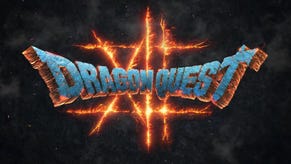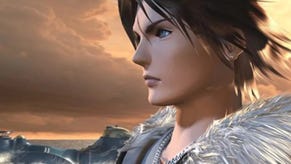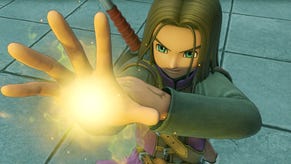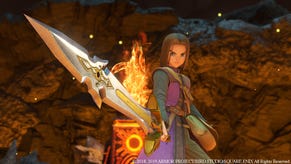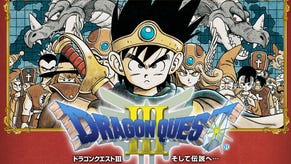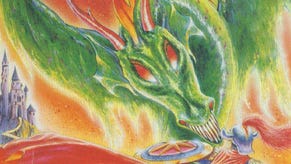The History of RPGs: How Dragon Quest Redefined a Genre
COVER STORY: 30 years ago, a small team of Japanese game designers changed the way the world looked at role-playing games.
This article first appeared on USgamer, a partner publication of VG247. Some content, such as this article, has been migrated to VG247 for posterity after USgamer's closure - but it has not been edited or further vetted by the VG247 team.

The goliath
Clearly Dragon Quest resonates in a similar way for many people, as each new numbered entry in the saga always sells millions of units — that, despite Japan's fading console games market. It's been described as a legacy series, in the sense that parents who grew up loving the 8-bit games are eager to share the magic of Dragon Quest with their own children. In America, you see a similar attitude with the Star Wars films. But Dragon Quest holds that place of honor in its homeland, and the most of the original staff behind the first game continues to provide the franchise's creative drive. Horii, Toriyama, and Sugiyama still contribute significantly to each new chapter; Horii in particular closely supervises every facet of the games, from sketching out ideas for new enemies to cowriting the scenarios.
Only Nakamura (along with Chun Soft, now Spike Chun Soft) no longer has any role in modern Dragon Quest... though his company still carries on the spiritual legacy of the series. Chun Soft's most prolific work, the Mystery Dungeon games, began as a spinoff of Dragon Quest IV. "Ultima and Wizardry are difficult games, but what we did with those games was to take them and make a more easy-to-understand version of them, which was Dragon Quest," says Nakamura. "We wanted to approach Rogue in a similar way, make a more understandable, more easy-to-play version of Rogue, which was the Mystery Dungeon series. Torneko's Big Adventure was the first title that we put out in the series." It's been more than a decade since the last Dragon Quest-themed Mystery Dungeon release, but the roguelike franchise has linked up with everything from Pokémon to Final Fantasy to Etrian Odyssey, and it always carries the same torch of accessibility and mass appeal that it inherited from Dragon Quest.
"Everyone knows what DQ is [in Japan]," says John Ricciardi of localization company 8-4 Ltd. "The generation that grew up with it on the NES are adults with disposable income now, so it’s arguably stronger than it’s ever been. We’ve got Dragon Quest toys, Dragon Quest food items, a Dragon Quest café, Dragon Quest live shows... it’s great. Hell, I have an Erdrick helmet on my desk, and the mini-carpet under my feet is a pixel staircase from DQ. I could walk up the street to the convenience store right now and buy Dragon Quest chicken nuggets if I wanted to! (I don’t want to. But I have the option!)"
Outside of Japan, however, Dragon Quest has had trouble gaining traction. Nintendo itself took up publishing duties for the original game in the U.S., significantly overhauling its workings. With the help of HAL and future Nintendo president Satoru Iwata, the NES version of Dragon Quest — renamed Dragon Warrior due to trademark issues — benefited from a number of quality-of-life improvements. The graphics looked nicer, certain commands were made less fidgety, and the cumbersome password save system was replaced with a convenient battery backup. Despite these tweaks and massive promotion in Nintendo Power, there was no getting around the fact that the game was more than three years old by the time it arrived in the U.S.

Where Dragon Quest was a revelation in 1986, Dragon Warrior in 1989 had to compete against more advanced NES contemporaries like Mega Man 2, Ninja Gaiden, and Super Mario Bros. 2. Unlike in Japan, Dragon Warrior didn't serve as a universal entry point to the role-playing genre for NES fans. Pony Canyon's middling NES port of Ultima III: Exodus — which had helped inspire Dragon Quest in the first place — beat Dragon Warrior to the punch. Worse, several games that had incorporated Dragon Quest's RPG mechanics had already arrived in the U.S., including Zelda II: The Adventure of Link and Castlevania II. In fact, Nintendo published Hudson's Faxanadu within a month of Dragon Warrior — a game that drew heavily on Zelda II, making it twice removed from Dragon Quest. In other words, by the time Dragon Warrior debuted, NES fans had already been introduced to RPG concepts, and those introductions came in the form of exciting, visually appealing, fast-paced action games. By comparison, Dragon Warrior felt sluggish, simplistic, and old.
Even so, many American NES owners who took a chance on Dragon Warrior saw the appeal beneath its primitive visuals and pokey pacing. Those who pined for a proper RPG experience on NES understood what the game was really about, and found that action-driven distillations of the genre such as Zelda II didn't quite do the trick.
"I was a fan of the series before I even played it!" says Ricciardi. "Mainly from the little teaser blurbs in game magazines and the Official Nintendo Player’s Guide and the like. I was intrigued by the stories about people skipping school and lining up to buy the game in Japan, and the Japanese box art for the early games (especially DQIII!) just looked so badass and inviting. I really wanted to explore those worlds, so when the first game arrived in English in 1989, I was there pretty much from day one. I spent a good month of my summer running (okay, walking... very slowly) around Alefgard, and I loved every minute of it.
"RPGs have always been my favorite, and that all started with Dragon Quest. I didn’t own a PC that could run Ultima, but man did I dream about those games growing up! So in a sense, you could say Dragon Quest filled that void, too.

"But more importantly, it helped ignite my love affair with Japan. When Dragon Quest V for SNES ended up not coming stateside, I imported the Japanese version, picked up a couple of Japanese-to-English dictionaries, and started studying the language so I could play through the game. I taped hiragana and katakana charts to the desk in front of me while I played, and I took piles and piles of notes — writing down every item name, every magic spell, every town, castle, and monster... all so I could get through the game in Japanese. This is ultimately what got me interested in the Japanese language and Japan as a whole. I first visited in 1997, and I’ve now been living here for the past 16 years."
Ramachandran shares similar memories, though he came to the game without any real genre awareness. "Dragon [Warrior] was my very first RPG. I think a lot of North Americans started with Final Fantasy, but Dragon Quest was my first. Back in 1989 or so, there was a deal in Nintendo Power to get a free copy of Dragon Warrior with your subscription. I jumped at the deal, not really knowing what I was getting into, and I fell in love with the game the instant I turned it on."
And Dragon Warrior's slow-paced gameplay wasn't a drawback for everyone; for others, it was a huge part of the game's appeal. "As a kid, I enjoyed action games but also found enjoyment in a slow and methodical roleplaying experience when I just wasn't feeling the twitch experience," Fraioli recalls. "My first RPG was Phantasy Star; it was the only non-action game I owned for years. When we got our NES and I discovered Dragon Warrior, it was an affirmation that there were more of these things, and I ended up completing the first three games with my father and brother. It holds a strong nostalgic tie with me for that reason, but also because I just love a game that I can slow-grind and not worry about whatever else is going on in my life."
Dragon Quest immediately inspired a slew of imitators in Japan; do a quick survey of the Famicom console's library and you'll find that the only genres more prolific on that platform than Dragon Quest clones were baseball games and Mario knockoffs. The best of these derivative works added their own unique flavor to the genre: Phantasy Star added spacefaring and manga-style illustrations. Final Fantasy initially pushed Japanese RPGs back in the direction of their Western inspirations before venturing into the melodramatic monster we know it as today. Megami Tensei added a modern setting and demon-collecting mechanics. Tales of Phantasia incorporated a lively real-time battle system inspired by fighting games. Pokémon integrated player-versus-player combat. And yet, all of these games owe much to Dragon Quest, which created a brilliant foundation for other creators to build upon.
Of course, it's not just Japanese developers who have looked to Dragon Quest for inspiration. Plenty of Western developers, especially independent game designers, are well aware of what they owe to that classic series.
Robert Boyd of Zeboyd games admits that while his current project, Cosmic Star Heroine, is patterned largely after SEGA's Phantasy Star series, it was Dragon Quest that helped get his studio started in the first place. "The blatant DQ homage Guadia Quest (in Retro Game Challenge) was the big impetus to me thinking, 'Hey, I could do this! I could make my own RPGs professionally,'" he says. "And if you look at our first RPG [Breath of Death VII], it's obviously a NES Dragon Quest parody with the 4 character party, simple tile-based graphics, and first-person perspective battles."
Likewise, Ramachandran is only too happy to describe Dragon Quest's influence on his own career. "It's influenced me immensely," he says. "Dragon Quest has this amazing juxtaposition of adorable creatures and dark, heavy storyline. Whether it's getting married in Dragon Quest V or reviving a dead world in Dragon Quest Builders, you always have these surprisingly heavy themes and story beats that maintain their impact, but are cushioned by this cheery art style. You don't get bogged down by the depressing story, because everything around you looks so cute and fun.

"That's something I want to be able to do. Deal with heavy themes, dark story beats, real things that we all deal with in our lives, but package it in something that's fun and adventurous. You can tell these types of stories without the player saying, 'Man, this is too heavy. I need to take a break.'"
And perhaps this is the essential strength of Dragon Quest that's helped the series endure for so many decades: The deft manner in which it straddles light and dark. It's why the humble slime has become a symbol of the games. Dragon Quest has understood from the beginning that whimsy and danger can coexist, that heavy moments feel all the weightier when you have levity for contrast. Wed that philosophy to rock-solid play mechanics, brilliant artwork, and memorable worlds, and you have the makings of a true RPG classic. Dragon Quest casts a long shadow over the medium, and deservedly so.
"Other than maybe Wizardry, you'd be hard pressed to find an RPG that has more of a legacy than Dragon Quest," says Boyd. "Pretty much every JRPG owes something to Dragon Quest."

